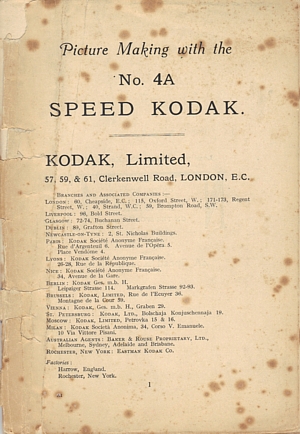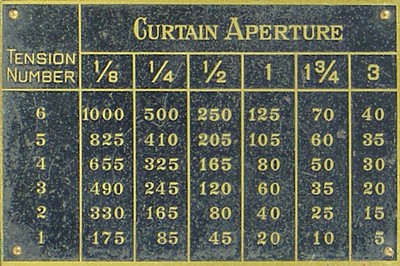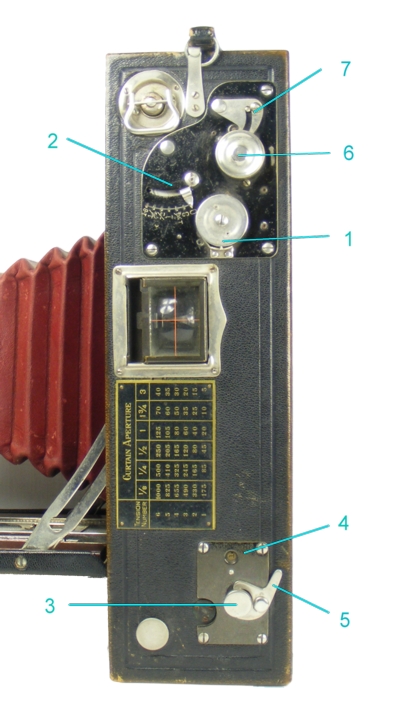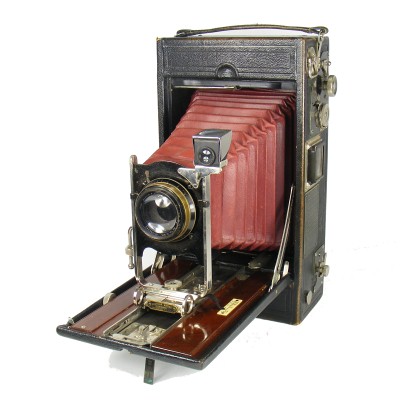No 4A Speed Kodak Camera
Eastman Kodak Company
The No 4A Speed Kodak is another large vertical format folding camera for 126 rollfilm (as used in the No 4A Folding Kodak also).
The camera could be purchased without a lens so that the user could fit one of their choosing, or otherwise a lens could be supplied, such as a Zeiss Tessar or a Cooke lens.
| Plate / Film Size: | 126 rollfilm for pictures 4¼" x 6½". A plate adapter was also available as an optional extra. |
| Lens: | None - refer to description below |
| Shutter: | Kodak Focal Plane |
| Movements: | None |
| Date of this Example: | c1909 |
| Serial Number: | Serial 720D on support stand. Batch id 784 stamped onto one end of the removable back (inside) and repeated on the inside face of one of the side panels. |
| Availability: |
|
| Inventory Number: | 361 |
|
Photos copyright © 2012 David Purcell. Do not use without permission. |
Description
The No 4A Speed Kodak is a large square ended folding bed camera with integral focal plane shutter. The camera is in very good cosmetic condition, with only very minor marking to the leather body. In particular there are clear ring markings around the tripod mounting point, showing that it had been used. This eample did not come with a lens, but was sold in that form anyway in many cases.
There is minor damage to the red bellows, where a few black markings on the edges show where the outer skin is worn. The folds nearest the lens mount are not very rigid, suggesting some separation in the layers of the bellows.
The brightwork, controls and finder are all in very good order. The handle is intact.
All in all, one of the better examples to turn up on eBay. This example was purchased from a seller in the US.
It is quite difficult to appreciate the sheer size of this camera. As a means of comparison, one of the photos above includes a Vest Pocket Kodak camera alongside the No 4A Speed Kodak.
 |
|
 |
An instruction booklet for the camera was bought separately. The booklet was published by Kodak Ltd, but no date is shown. The covers are tatty and have split down the spine, but the remainder is in good order. It may be that the booklet originally had an external card covering over the paper cover shown, but there is no evidence to suggest that this is the case. The fact that the booklet was published by Kodak Ltd in London indicates that the No 4A Speed Kodak must have been available in the UK, but I have as yet to see an example for sale in the UK or Europe. The final pages of the booklet include a price list. The price of the camera without lens is listed as £10 10 shillings. An f4.5 Zeiss Tessar lens is another £8, although a number of alternate lenses are listed such as a Beck Iostigmar and Goerz Series III, but all are of a comparable price. It was a very expensive camera for this period. |
Shutter Operation
Examples of the No 4A Speed Kodak are quite hard to find and rarely turn up outside the US.
To load the camera the back panel is removed (two hidden push buttons on the sides release it); the side panels of the camera can then be swung back (they are hinged along the front edge) to provide access to the bays where the film spools are held. Note that the handle has to be unclipped to allow the end panel to swing out.
 |
|
 |
First the basic principles of the shutter. It consists of a cloth curtain that passes across the face of the film. The curtain has an adjustable aperture (slit width) and is tensioned by a spring built into one of the rollers in order to vary its speed of travel; these two factors regulate the exposure. A table is shown on the top face of the camera, alongside the finder, that shows the speed achieved for a given tension and aperture width. The maximum is 1/1000 of a second. |
The picture below shows the various controls for the focal plane shutter that are located on the top face of the camera body. The photo has been annotated to number the various controls.
 |
|
 |
Step 1 is to select whether you want a Time or Instantaneous exposure by turning the dial (1) to the appropriate position identified by a pointer located just below the dial. Step 2 is to set the curtain aperture (slit width) to the appropriate setting. The width of the aperture is set by moving the aperture indicator (2) until it points to the desired aperture. Available settings are ⅛, ¼, ½, 1, 1¾, 3 and 0, where each number corresponds to the width of the aperture in the curtain expressed in inches. Step 3 is to set the curtain tension. The spring tension is set by turning the milled head (3) until the required speed tension is indicated on the tension dial (4). Step 4 is to wind up the curtain. This is done by turning the milled head (6) until it cannot be turned any further. The instructions state that after about 8 turns it will resist a little as the safety blind arrives at the top roller. Continue winding until fully set. Step 5 is to set the aperture on the lens to the appropriate setting for the conditions. Finally, the exposure is made by pressing upward on the release (7). |
Note that once the curtain has been wound, the aperture (slit width) cannot be adjusted. If it needs to be changed, the lens needs to be capped so that the shutter can be fired. The aperture can then be reset to the required setting and the curtain then has to be wound up again. If the selected tension is higher than desired, it can be reduced by pressing the lever (5) until the required value is shown on the dial.
The '0' setting on the aperture indicator (2) means that the aperture is fully open (that is, 6½ inches wide) and is only used when making a time exposure. The procedure for Time exposures is similar to the steps described above, except that the 'T' setting is chosen on the dial and the aperture width is set to '0'. The remainder of the setting process is the same, although the shutter release is pressed twice: once to open and then, after the required time, it is pressed again to close the shutter.
The curtain on this example appears to be complete, with no obvious damage, but no longer operates correctly. That is not at all unusual with shutters of this type and age.
Notes
This example was not fitted with a lens when I purchased it. The lens shown in the photographs is a f6.3 Zeiss Tessar, which looks right on the camera, but isn't of quite the correct form as it has a longer focal length than would normally have been used. I bought the lens separately.
When I first generated this page, I noted the production period as 1908 - 1913 based on other references. and therefore that "this example probably comes from the middle of the period judging by the serial number.". Further investigation has confirmed that the camera was listed in catalogues from 1908 to 1912. However in early 2021 I was included in discussions with another researcher about the 4A Speed Kodak, which led to the relevant extract of the Production Order Book being obtained from the records at George Eastman Museum (GEM). This revealed that a single batch of 1000 cameras was produced in late 1906, though shipping did not start until early 1907. No further batches were produced, although clearly a number of the cameras were sent over to Kodak Limited in London.
Given the limited production run, it is apparent that the camera did not prove particularly popular. The 1A Speed Kodak that was introduced a year later took much smaller pictures (2½ x 4¼ inches) using 116 rollfilm and was significantly smaller and lighter. The corresponding extract from the Production Order Book for the 1A Speed Kodak makes for interesting comparison, as the 1A Speed Kodak was produced in a series of batches from December 1908 to 1910, with a total production run of more than 2000 over this period, though still not substantial numbers. The Kodak Trade Circular for April 1909 makes the following comment that seems to reinforce the view that the sales of the 4A Speed were limited ...
The much more bulky and expensive 4A Speed Kodak is selling steadily, and will continue to sell to people who want the larger pictures. It’s a good camera, and it is worth your while to push it, but you can sell more of the 1A Speed Kodaks, for the same reason that you can sell more 1A Folding Pockets than you can 4A Foldings. There are more people who are willing to spend the smaller price.

![[ ]](../../images/unchecked.png)
![[x]](../../images/checked.png)








